It’s not just great code that’s behind every successful product, but a partnership built on clarity, trust, and shared goals. At Magebit, we believe that how we work together is just as important as what we build. That’s why our engagement model, the framework that defines how we collaborate, communicate, and share responsibility, becomes the foundation of every successful partnership.
Building Partnerships that Last
At the core of our partnerships is continuous learning and improvement - both for our clients and our team. Our involvement in the local and international tech scene, from organizing e-commerce Latvia and Shopify Latvia events to sharing our knowledge on stages in Florida and New York, helps us exchange ideas, adopt global best practices, and stay at the cutting edge of digital commerce innovation.
We run internal learning programs through our internal Magebit Academy, where team members expand their technical, foundational, communication, and leadership skills, ensuring every client benefits from a culture of growth and expertise.
We’re also experimenting early and responsibly with AI, using our Custom Magebit AI to optimize workflows, improve estimation accuracy, and turn data into faster, smarter project decisions.
Explore how Magebit works and why we are the number one Adobe Commerce agency in the world →
We adapt our collaboration approach to fit your goals and business context. Whether it’s a fixed-scope project, a flexible time & material approach, or a dedicated team that grows with your brand - the way we work always fits you, not the other way around.
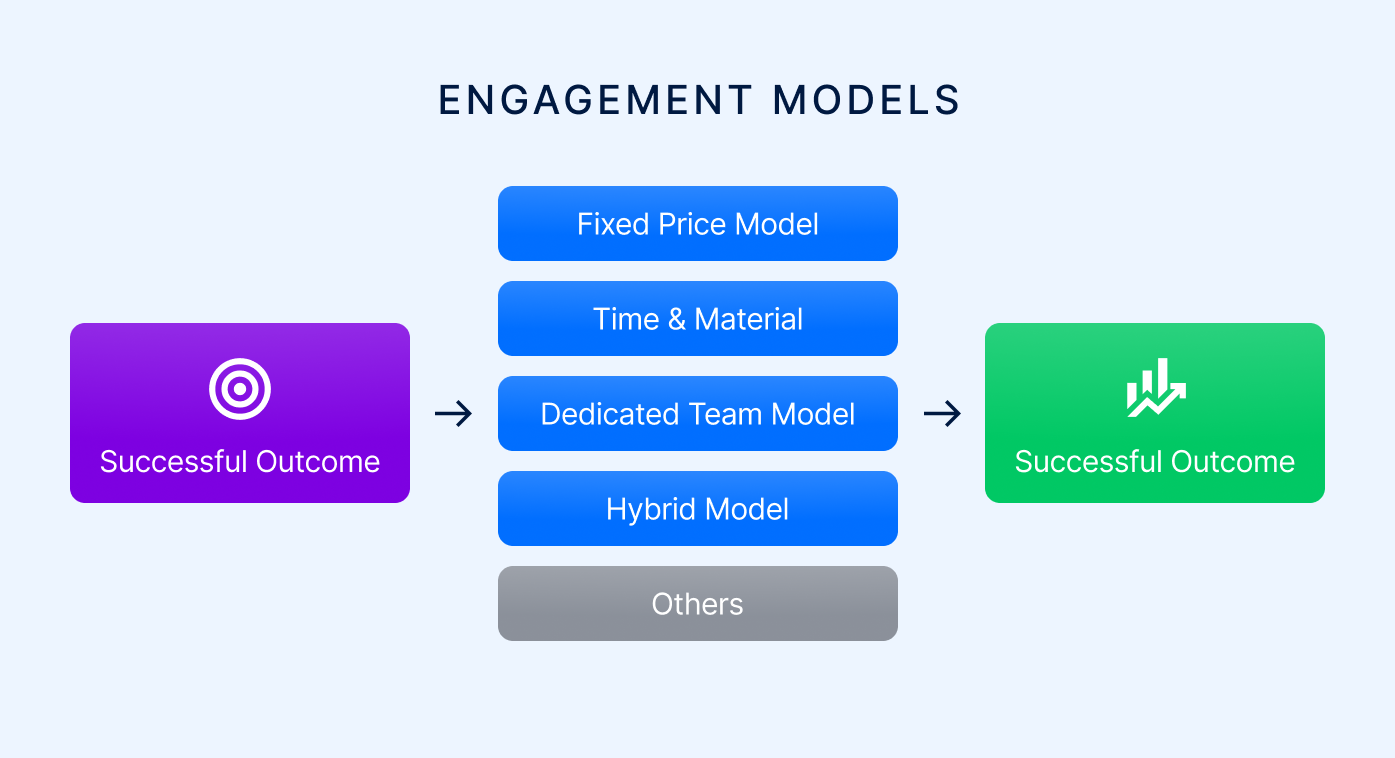
The Most Common Engagement Models
Below, we explore the four engagement models most often used in digital projects, especially e-commerce projects, and how Magebit works with each one.
1. Fixed-Price Model
A Fixed-Price model is one of the most traditional and widely used engagement approaches in software development. It works best when the project scope, timeline, and deliverables are clearly defined from the start. The client and vendor agree on a fixed cost for a specific set of outcomes, creating predictability and clear accountability for delivery.
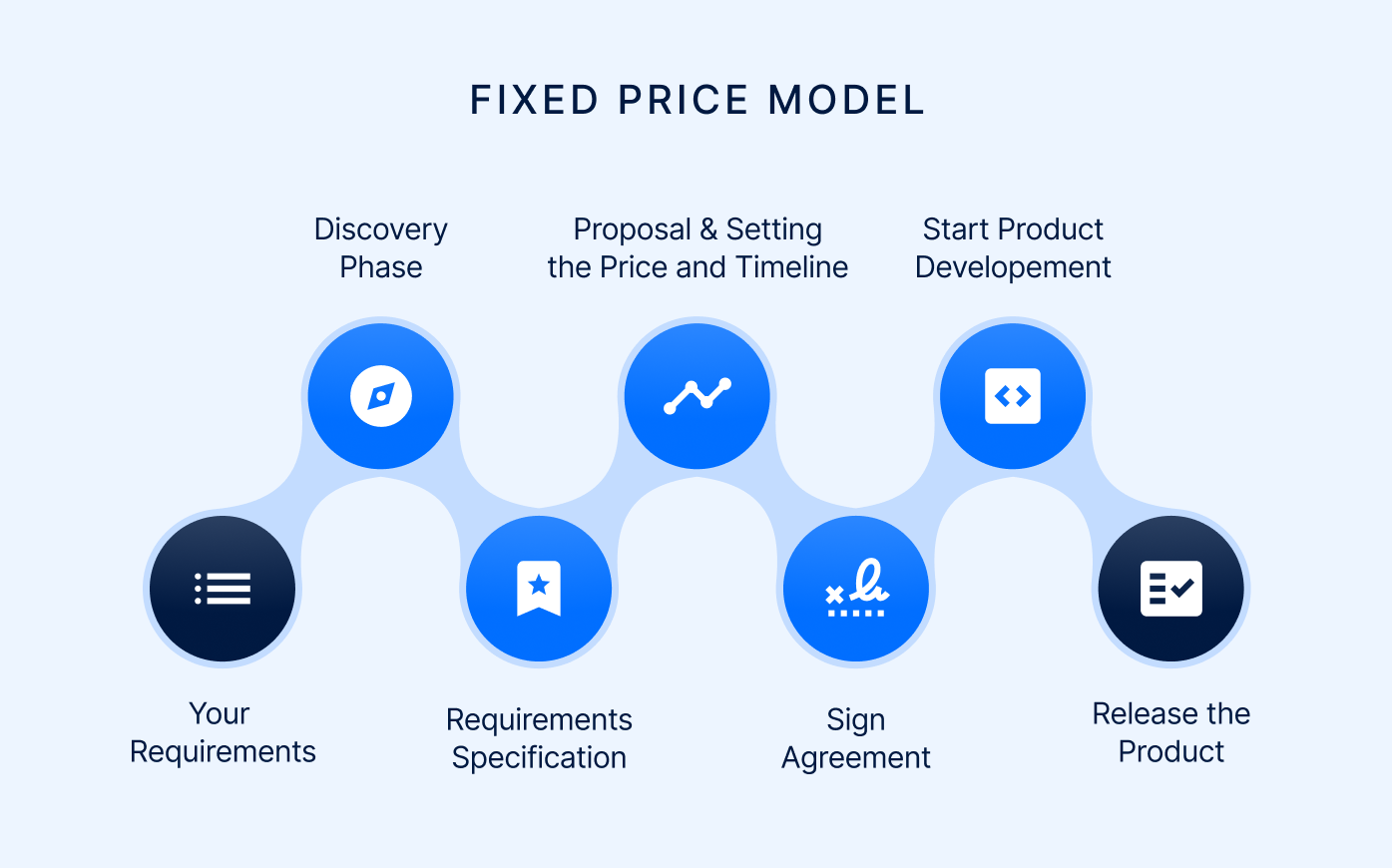
Unlike the Waterfall model (which often lacks flexibility), modern Fixed-Price projects can still follow Agile principles, using short iterations, demos, and regular feedback cycles to ensure progress stays aligned with business goals. This combination allows you to maintain cost control without losing adaptability.
At Magebit, we use an Agile Fixed-Price approach, where milestones are structured, but scope refinement and testing happen continuously. We apply Agile ceremonies such as iteration planning, backlog refinement, and demos even within fixed contracts, ensuring alignment and adaptability at every milestone. This ensures that every iteration adds measurable value, not just completed tasks.
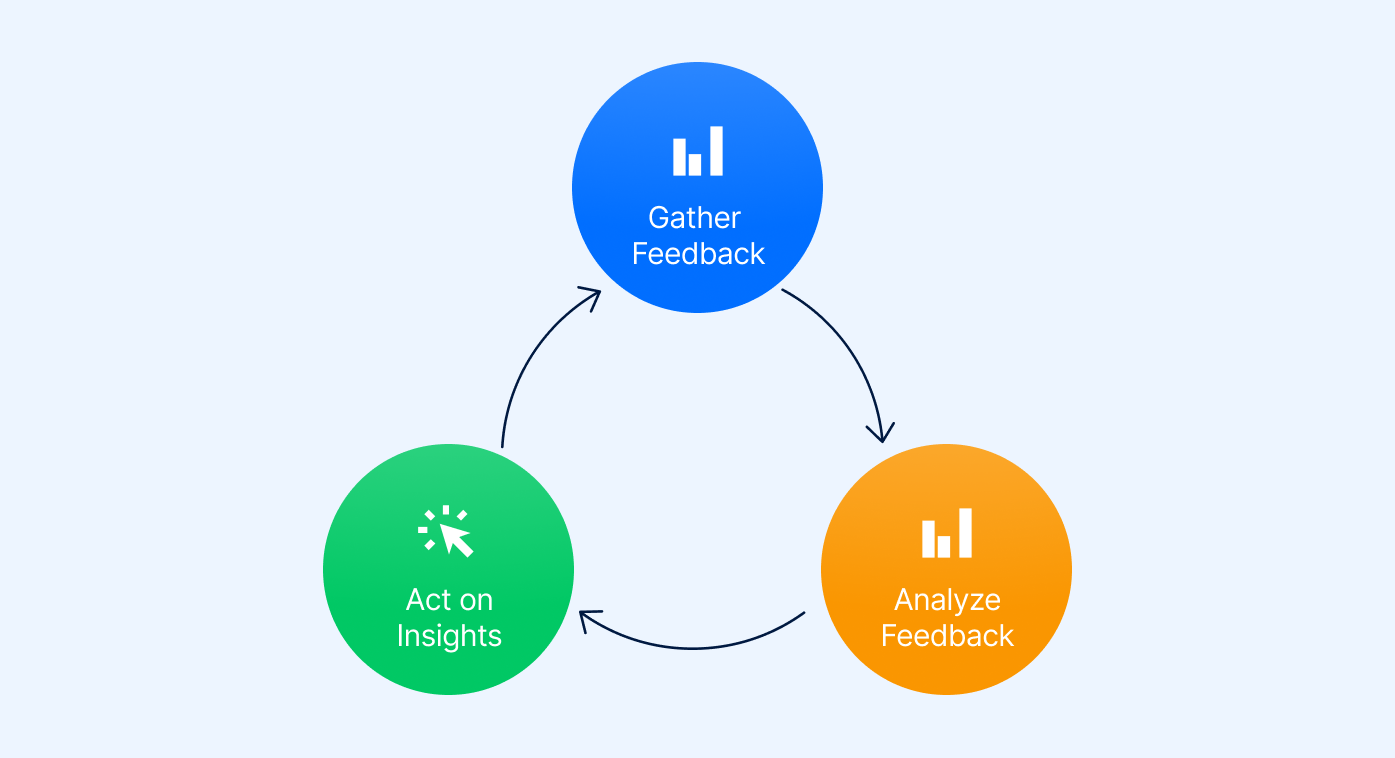
Example of the Fixed-Price Model
An established fashion retailer came to Magebit to redesign their Magento storefront before the new season launch. The project was set on a fixed-price basis with clear design and go-live deadlines. During the development phase, user testing revealed opportunities to simplify checkout.
With Magebit’s agile approach to fixed-price projects, we were able to reallocate effort within the same budget, delivering a smoother checkout experience and a higher conversion rate without extending the timeline.
When to Use the Fixed-Price Model
- Small to mid-sized projects with well-defined deliverables.
- Clients with strict budget requirements.
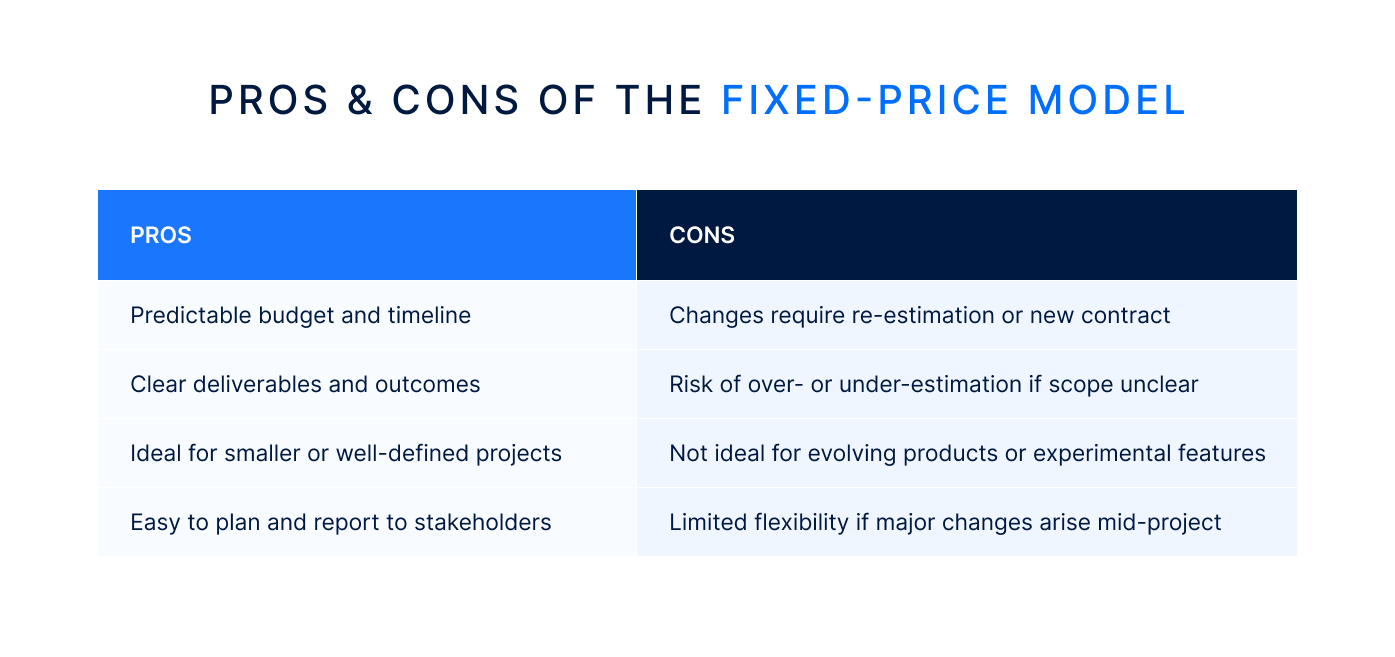
2. Time & Material (T&M) Model
The Time & Material (T&M) model is built for flexibility and adaptability. Instead of agreeing on a fixed scope upfront, the client pays for the actual time and effort invested by the development team. This model is ideal for projects where requirements may evolve or priorities change frequently, such as ongoing optimization, A/B testing, or early-stage product development.
In a T&M setup, the focus is on continuous value delivery. You can test, iterate, and pivot without being restricted by fixed contracts, which is perfect for dynamic industries like e-commerce, where customer expectations and technology evolve rapidly.
How Does the T&M Model Work
In practice, this model translates into a simple, iterative process focused on continuous alignment.
- The project is divided into short iterations or phases.
- After each iteration, the client reviews progress, approves outcomes, and can re-prioritize next steps.
- Billing is typically based on hourly or sprint-based rates, giving full transparency and control over budget use.
At Magebit, we often recommend this model as a starting point for collaboration, especially when the product vision is clear but the exact implementation path is still taking shape. Sometimes, committing to a full dedicated team right away can feel too big. A T&M setup helps both sides build momentum, align workflows, and establish trust.
Magebit ensures complete transparency through detailed time tracking, iteration-based reporting, and proactive communication so that you always stay in control of both progress and costs.
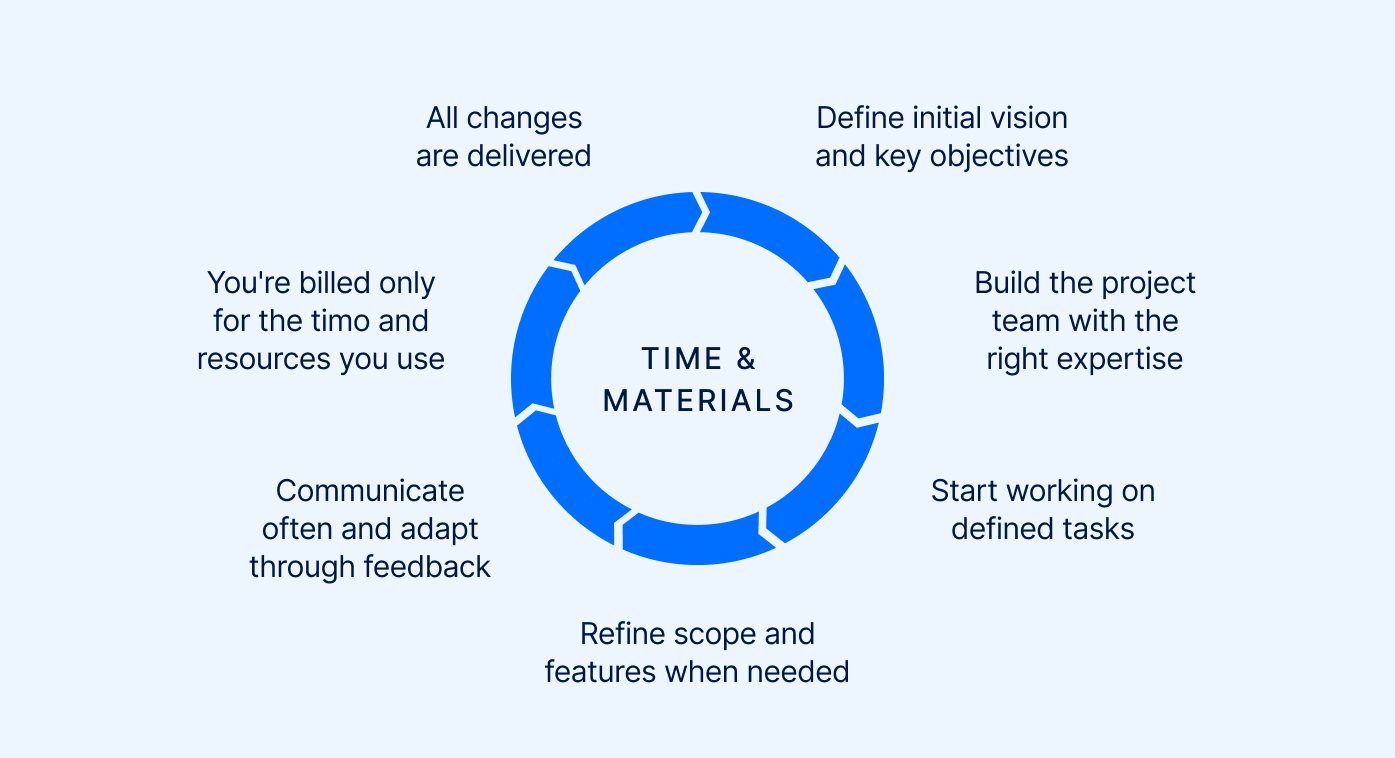
Example of the T&M Engagement Model
An e-commerce startup approached Magebit to run A/B testing and ongoing feature improvements for their online store, leading to a 15% faster rollout of new features and improved conversion rates.
Instead of building an entire team from day one, we started with a small T&M collaboration focused on iterative testing. Once the results proved successful, the cooperation scaled smoothly into a dedicated agile team for long-term development and continuous innovation.
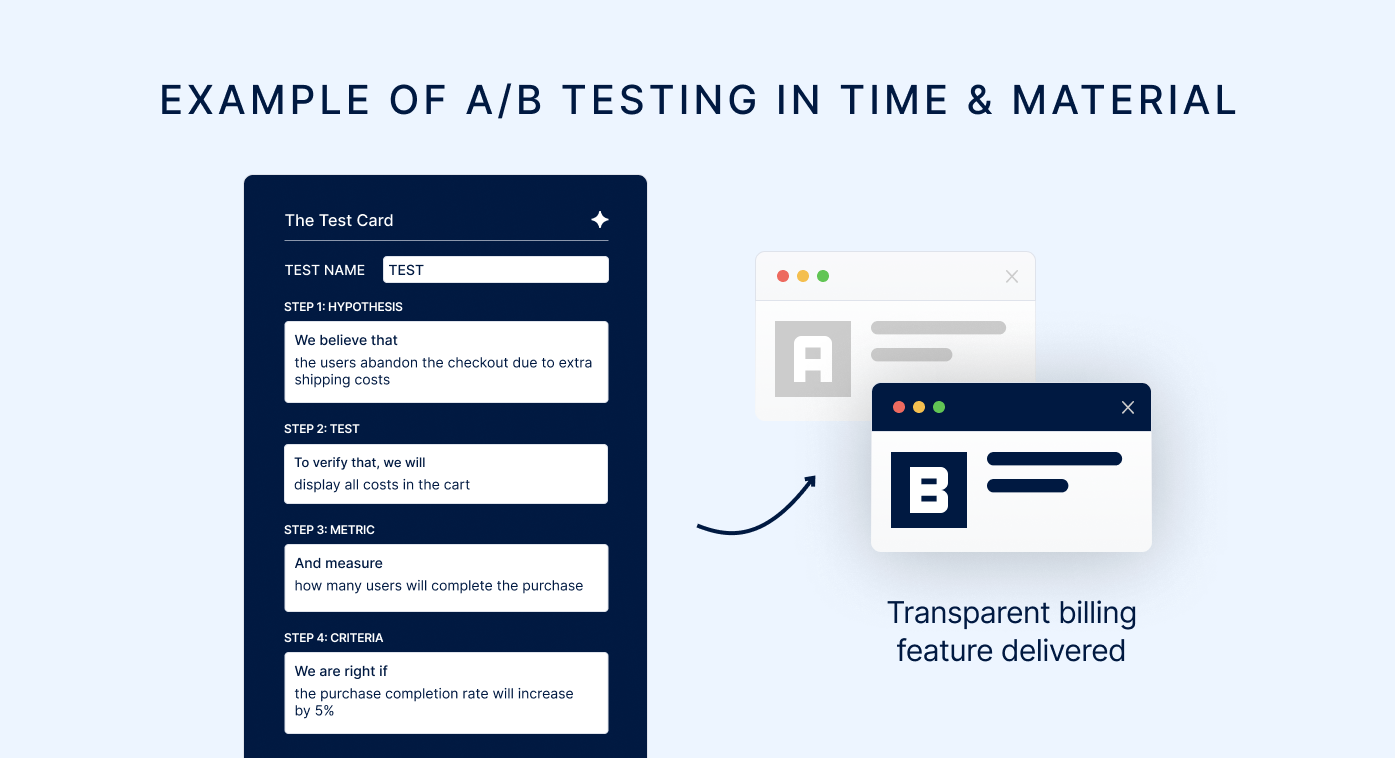
When to Use the T&M Model
- MVPs or proof-of-concept projects.
- Existing website life-support maintenance projects.
- Developing new e-commerce functionalities.
- Building custom Magento or Shopify modules.
- Running A/B tests or optimizing performance with evolving requirements.
- Starting collaboration before scaling to a dedicated team.
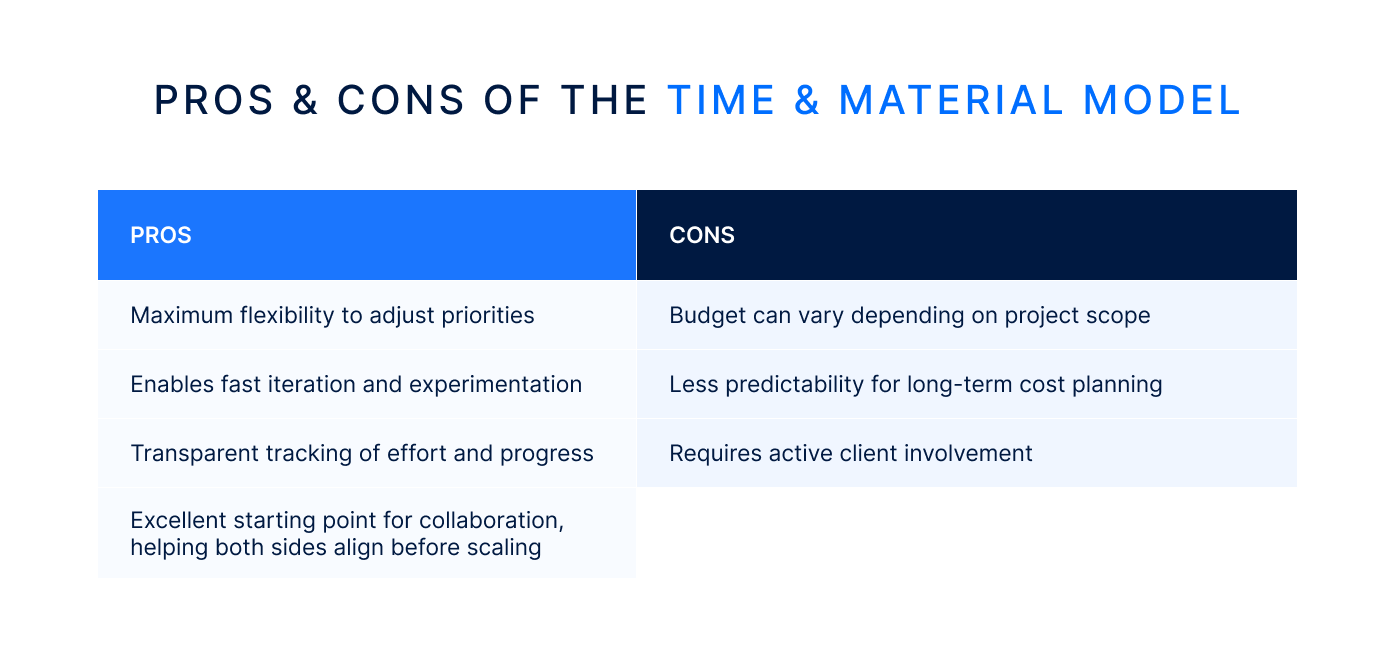
3. Dedicated Team Model
The Dedicated Team model is built for long-term collaboration and strategic growth. Instead of project-based delivery, you get a fully integrated, cross-functional team that works exclusively on your product, acting as a true extension of your organization.
This model provides ongoing agility, continuous delivery, and deep business alignment, making it the most popular collaboration framework among enterprise companies. For years, global players like Accenture and other large IT consultancies have relied on dedicated teams to support complex, long-term digital operations.
Today, the same approach is increasingly adopted by specialized e-commerce agencies like Magebit, particularly for e-commerce-focused dedicated teams, where deep platform knowledge, flexibility, and business understanding are essential.
How Does the Dedicated Team Model Work
The mechanics of this model are designed to integrate deeply with your long-term strategic goals.
- The client defines long-term goals and expected outcomes rather than a fixed scope.
The vendor assembles a dedicated team (designers, developers, QA engineers, strategists, etc.) that works exclusively for the client. - The collaboration follows Agile methodology, allowing continuous delivery, sprint planning, and backlog prioritization.
- The client retains full transparency and control, while the vendor manages recruitment, HR, performance, and process improvement.
At Magebit, unlike static internal teams, the dedicated model also gives you the flexibility to add or remove specialists as your priorities evolve, whether you suddenly need an SEO strategist, a data engineer, or a conversion optimization expert. This adaptability ensures you always have the right talent at the right time, without long recruitment cycles or overhead costs.
Many of our clients start with a Fixed-Price or Time & Material project and then transition into Dedicated Agile Teams as their business grows. This approach delivers quick wins early on and a sustainable development rhythm for the long run.
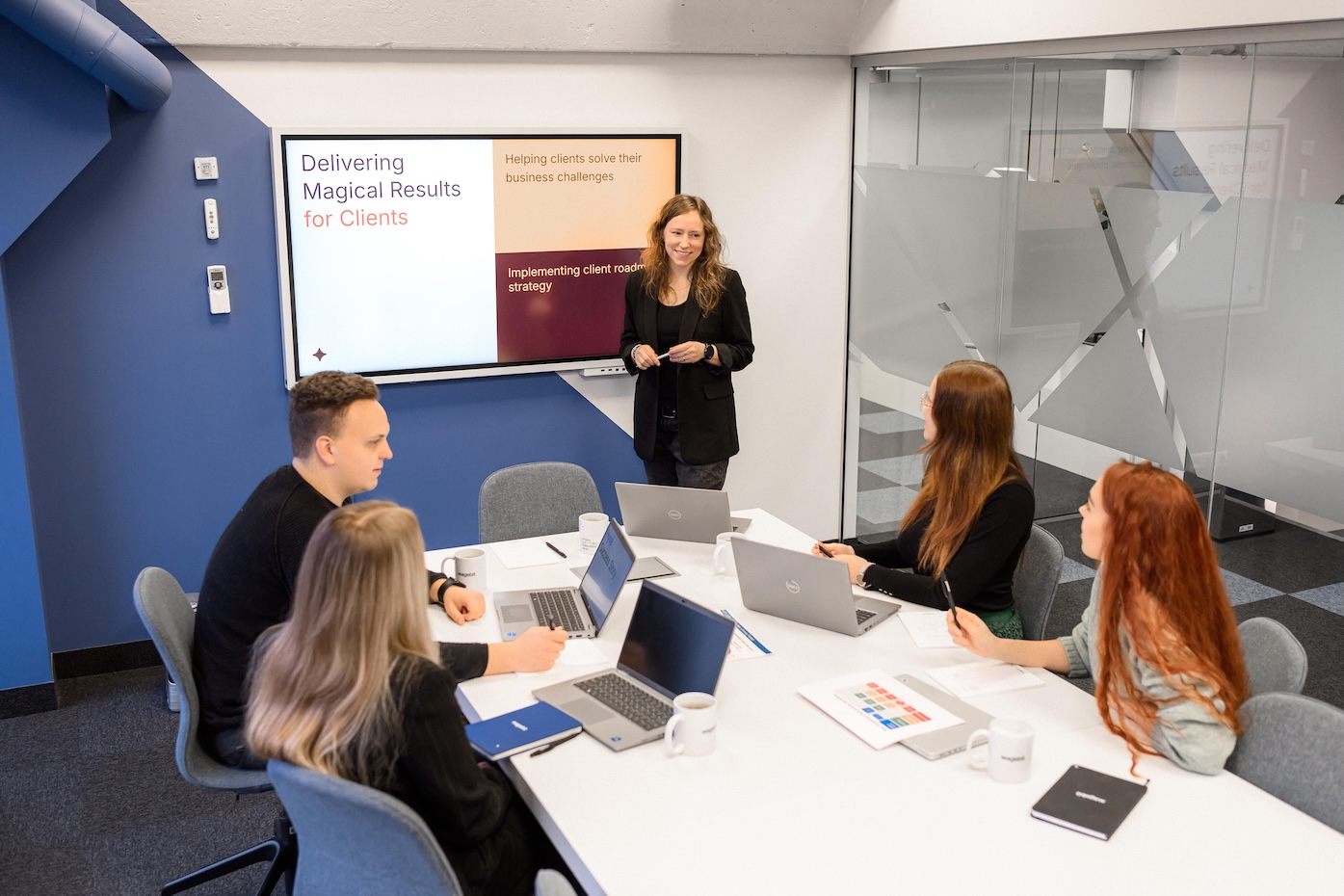
Dedicated teams don’t just deliver - they continuously optimize, eliminating inefficiencies across development, strategy, and operations, and becoming a natural part of your organization’s success story.
📊 SW Development Statistic research shows that companies maintaining long-term IT partnerships experience lower maintenance costs over time.
When to Use the Dedicated Team Model
- Continuous product development and platform growth.
- Long-term e-commerce optimization and innovation cycles.
- Businesses that value stability, agility, and deep collaboration.

4. Hybrid Model & Retainers
Sometimes one size doesn’t fit all, and that’s perfectly fine. The Hybrid Model combines the best elements of different engagement approaches, typically mixing the structure and predictability of a Fixed-Price project with the flexibility and scalability of a Time & Material model or Dedicated Team.
This setup provides both control and adaptability, allowing companies to plan for stability while still leaving room to innovate as the project evolves. It’s a particularly powerful model for growing e-commerce businesses that balance stable product development with ongoing optimization, marketing, and experimentation.
How Does the Hybrid Model Work
This approach allows you to structure the collaboration in phases, matching the right model to the right task.
- A project often starts with a fixed scope (such as migration or redesign) for predictable delivery.
- Once launched, ongoing enhancements, A/B testing, and optimization continue under a Time & Material or Dedicated Team setup.
- The mix of models provides cost efficiency for predictable tasks and flexibility for evolving goals - all under one coordinated partnership.
But that’s not all. In parallel with these engagement models, Magebit also offers retainer-based services, from SEO/AEO optimization to email marketing, UX/UI design, and much more. These services can be seamlessly integrated alongside your main development model, whether fixed, T&M, or dedicated.
This means you can keep your core development team focused on growth, while our specialists handle continuous marketing and optimization in the background with minimal effort from your side. The result? Efficient communication, stronger alignment, and outstanding business outcomes.

Example of the Hybrid Model
A global pharmaceutical brand partnered with Magebit to upgrade its e-commerce platform under a Time & Material collaboration. After launch, the cooperation evolved into a hybrid model, where a Dedicated Team managed ongoing development and UX improvements, while Magebit’s retainer-based SEO and email marketing services ensured continuous optimization and visibility.
This setup created highly efficient communication and delivered outstanding results, driving more loyal customers through email campaigns and increasing purchases from organic traffic. This setup was a perfect fit for this enterprise as the collaboration costs were easily predictable.
When to Use the Hybrid Model
- Enterprises that are working on multiple projects at the same time.
- Growing e-commerce companies that need both structure and flexibility.
- Brands combining fixed-scope projects with ongoing optimization and campaign work.
- Businesses that benefit from continuous improvement through retainers (SEO, email, design, etc.).
In short, with Magebit, you don’t have to choose between control and agility. You can have both, and even more.
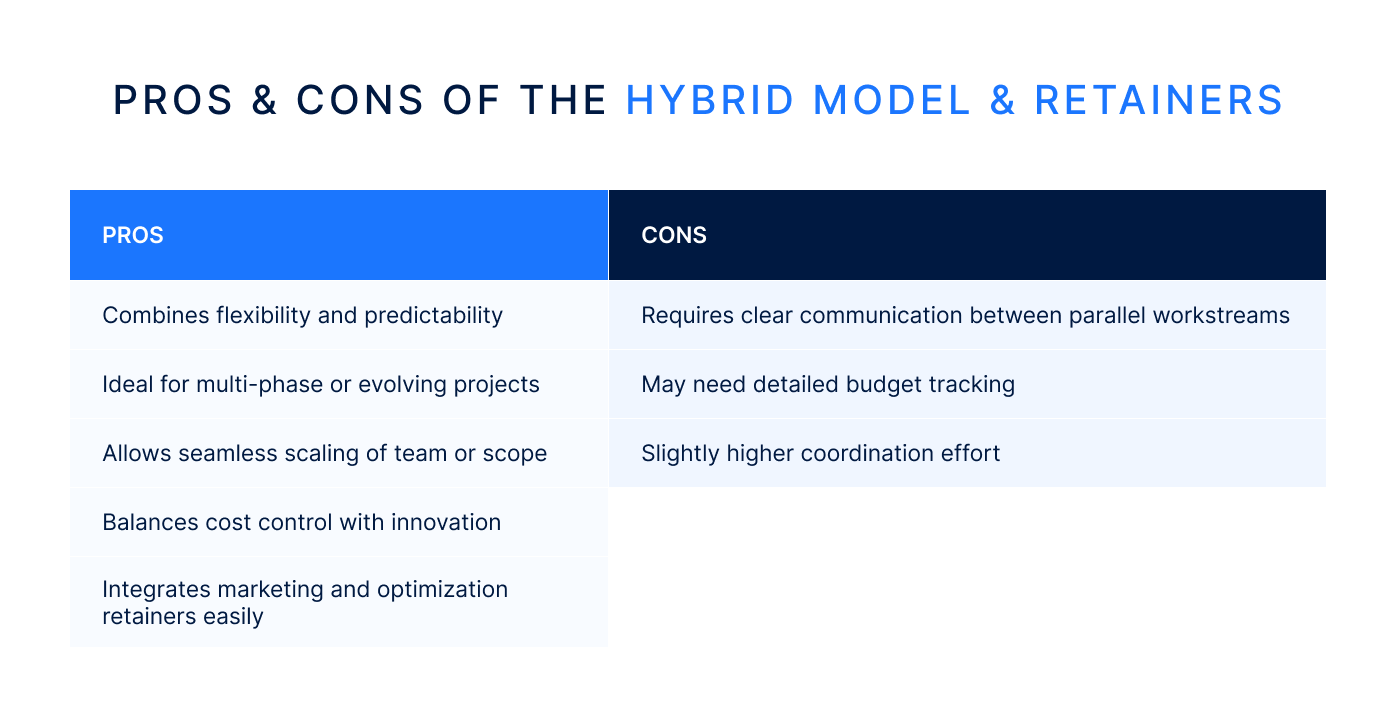
How to Choose the Right Engagement Model
Choosing the right engagement model depends on your goals, project maturity, and level of involvement. Start by asking yourself:
- Do I want full control, or do I prefer to delegate project management?
- Is my scope clearly defined, or will it evolve over time?
- Do I have an internal technical team, or do I rely fully on my vendor?
- What’s more important right now - speed, flexibility, or fixed cost?
If you’re not sure how to answer, our Account Managers will guide you through each step and help you choose the right engagement model. Our custom AI solutions, integrated into our team’s workflow at various touchpoints, analyze project requirements and expected outcomes to deliver exactly what you need, with no extra steps and the best possible results.
Still not sure? Look:
📊Across industries, average customer retention typically ranges around 72.5% (data from Customer Gauge Report).
Magebit maintains 83.7% long-term active client relationships, with many partnerships lasting over 8 years (internal data, 2025). Even more if we count silent relationships with new projects appearing periodically. This shows that our clients continue working with us, and the right engagement model plays a major role in building those partnerships.

How We Start Working With You
At Magebit, every collaboration begins with your business, your goals, and your challenges. Before writing a single line of code, we work to understand what success looks like for your brand and how technology can help you achieve it.
From the start, we help you choose the engagement model that fits your scope, timeline, and ambitions. One of our advantages at Magebit is that we have a vertically integrated company with experts across many domains in-house. Our team covers every angle:
- Account managers and strategists shape the vision and strategy.
- Project managers ensure structured, transparent delivery, define priorities, and ensure smooth execution.
- Specialists like UI/UX designers, data analysts, and developers bring it to life.
- Niche experts (i.e., Magento ERP sync experts) with incredible talent solve the toughest challenges.
- QA specialists and DevOps engineers ensure everything runs smoothly.
- Growth team improves your key sales metrics with SEO, AEO, email marketing, and more.
We rely on proven, industry-leading tools to keep projects transparent, collaborative, and efficient. Just to name a few:
- Jira for project management.
- Superhuman (Coda) for documentation and planning.
- Slack and Google Workspace (incl. Gemini) for communication.
- Cursor with self-made add-ons like Magento Toolbox and others.
- Proprietary n8n flows and internal software for advanced AI assistance.
- Figma for design collaboration and prototyping..
For visualization and creative brainstorming, we use in-house digital whiteboards, helping teams clearly map ideas, structures, and user journeys. And, if your organization already uses specific platforms or workflows, Magebit teams can seamlessly integrate with your existing tool stack to ensure smooth collaboration from day one.
Powered by our proprietary Magebit AI, we accelerate decision-making, predict risks, and continuously improve processes, learning from every project to deliver better results each time. That’s why our clients don’t just complete projects with us - they grow with us.
See how we’ve helped others succeed by exploring our case studies.
Final Thoughts
Selecting an engagement model is more than just a contract choice. It’s a strategy for success. The right approach helps you align teams, maintain clarity, and build long-term trust.
Ready to discover your best engagement model? Contact Magebit today, and let’s design the partnership that fits your goals perfectly.


















